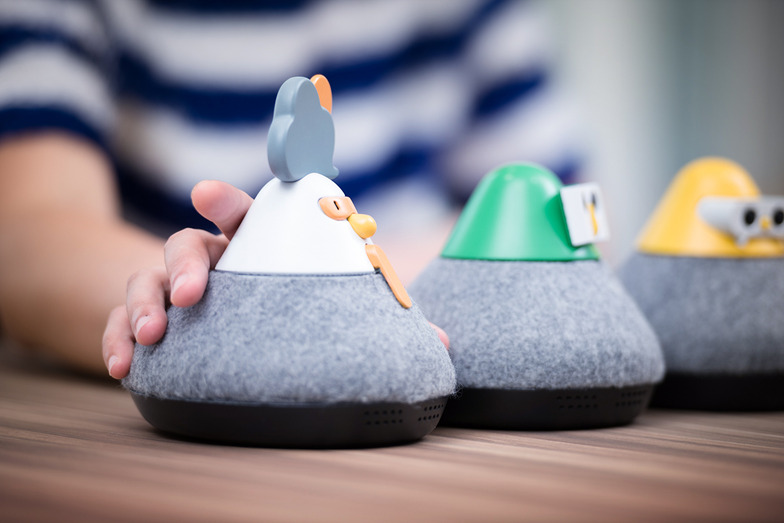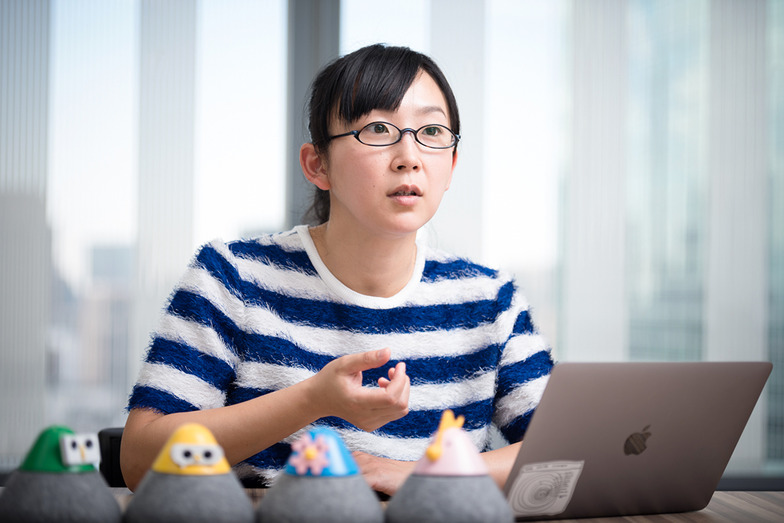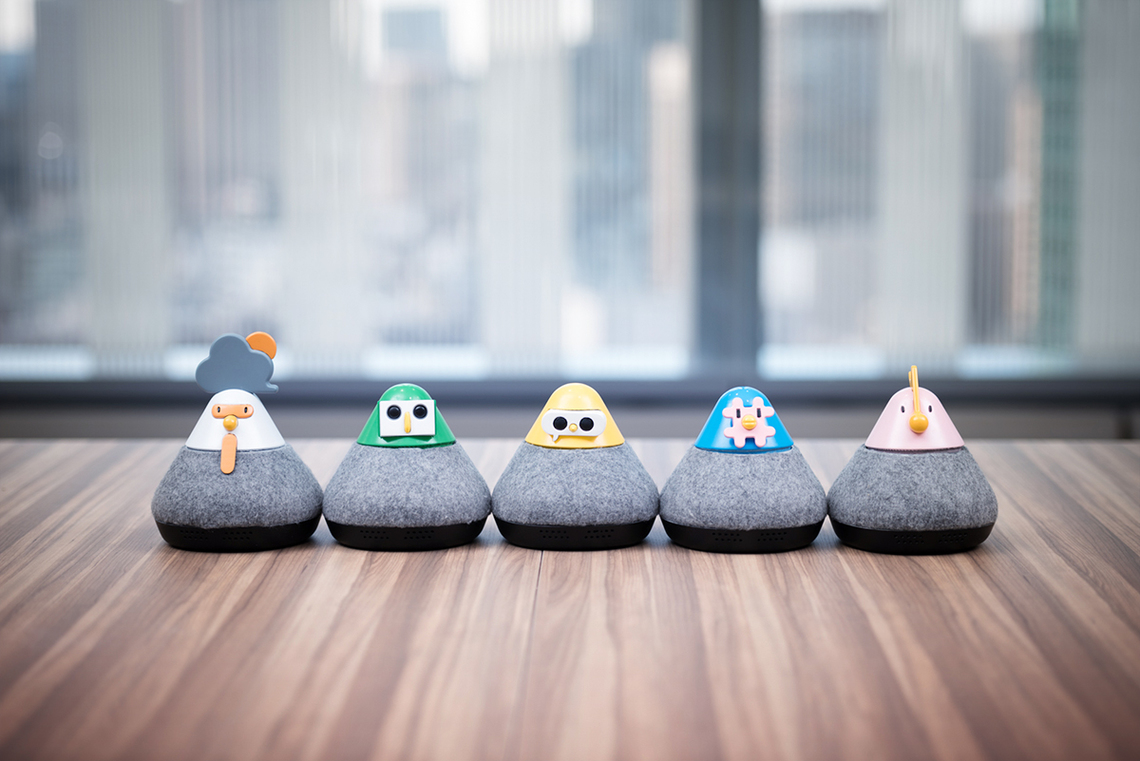Maybe a not-so-smart voice assistant isn't such a bad thing
──Right off the bat, could you tell us about your new product, COTOREES?
Nakano: COTOREES is a voice-operated, bird-shaped computer.
I started thinking it's a hassle to search for apps on your phone, and imagined how much easier it would be if apps could come out of the phone. I figured the user interface for that would be voice, not touch or switches. For voice-controlled devices, there are personal assistants like Amazon's Echo. That one's named Alexa.
──What is Alexa?
Nakano: Alexa is the name of the Virtual Personal Assistant (VPA) built into Echo. Apple has Siri, and they all have personalities, modeled after humans. That made me wonder: aren't there any options besides humans?
──What did you expect from non-human options?
Nakano: When something mimics a person, you tend to expect it to be incredibly capable, to perform perfectly. But sometimes it unexpectedly dodges your requests. So I thought, maybe a slightly "dumb" voice assistant—one that can only do one thing, not too smart—might be nice too.
──That's where the bird-shaped COTOREES comes in.
Nakano: Among animals, only birds can actually speak human language. Animals generally can't produce sounds beyond their natural calls, but humans and birds are the only ones who can learn "sounds" later. That's why chatty parrots or cockatoos can mimic voices. That led me to the conclusion that a non-human voice assistant should be a bird.
At first, I wanted it to sit on your shoulder.
──Each model has a single function. What are those functions?
Nakano: There's Hashbird, who searches for related tweets and talks nonstop when you hear a word that catches your interest; Transbird, who does simple translations; Hummingbird, who plays music; Wikibird, who looks up words you want to know and teaches them bit by bit; and Weatherbird, who tells you today's and tomorrow's weather.
──COTOREES has such cute designs.
Nakano: At first, I wanted it to sit on your shoulder.
──Huh?
Nakano: I thought it would be super convenient if something like this sat on your shoulder and answered questions. For example, if a traveler clipped COTOREES to their backpack, it could tell them where the hotel is or translate simple words. Actually, I haven't given up on the shoulder-riding ambition yet—there's a tripod hole, so it's possible if I decide to do it.
──Who handled the design?
Nakano: The overall design and engineering were handled by Mr. Hisaka from tsug.LCC, who also worked with us on "mico"—the headphones that recommend music based on brainwaves, which we unveiled at SXSW in 2013.
For the character design, we asked art director Hirose Horiuchi, who created Mister Donut's Pon de Lion. Cute that isn't moe-style has quite a bit of power. I think it's easier to empathize with than an inorganic design, and it might change how you approach things. Just living with COTOREES, I kind of hope it makes your speech a little gentler. Plus, it feels like it might forgive you even if you're not that smart (laughs).

Everything handled text-based should eventually be replaceable with voice.
──Earlier you mentioned "apps moving beyond smartphones." Could you elaborate on that?
Nakano: Harvard University's Innovation Lab released a concept video in 2014 called "The Evolution of the Desk." This video depicts everything on a desk being software-ized and absorbed into laptops and smartphones. For example, maps become Google Maps, business cards become LinkedIn... And this video ends in 2014.
When you think about what happens next, I imagine those things that became software and turned into icons will start moving back out of laptops and smartphones. That's the emergence of objects carrying information—the so-called IoT. Furthermore, the graphical user interface will shift to voice recognition. I think it will start with things like saying "Turn on the air conditioner" to operate appliances. Actually, it's already happening. Everything we currently handle with text will eventually be replaced by voice. As the clearest example of this, I wanted to introduce COTOREES to the world.
──I see, so the app became a physical object.
Nakano: COTOREES is a computer with a voice interface, but I see it as being in a field close to communication robots. However, it's not a high-performance communication robot designed to connect emotionally; I use the term "computer" because it's more function-oriented. Having something like COTOREES at home could create happy moments. This is also a core concept of neurowear.
Kevin Kelly (founding editor-in-chief of WIRED magazine) once spoke about the future of the internet, referring to AI not as Artificial Intelligence but as Alien Intelligence. What he meant was that because AI is human-made, we tend to think it "thinks like humans," but it actually operates on entirely different principles. COTOREES can speak human language, but it doesn't understand the words it speaks—that aspect feels close to what Mr. Kelly was saying.
──So COTOREES is Alien Intelligence, huh.
Nakano: Birds are said to be descendants of dinosaurs, and you never know what they're thinking—that sense of being "different" is really strong, isn't it? I think there's a feeling between humans and birds like two beings who've walked different paths yet speak the same language. That distance probably feels similar to the gap between mechanical intelligence and humans.

What's amazing about COTOREES is how unassuming it looks and how single-purpose it is.
──Was there anything particularly challenging during development?
Nakano: It's really obvious, but the voice recognition interface. Japanese has so many homophones, so that was a major problem. If you think of COTOREES as a species, having each one speak a different dialect would make them hard to use, so we spent time standardizing the interface.
──What does that mean specifically?
Nakano: I felt that when human-machine interfaces move away from being visual-based in the future, this aspect will become crucial, much like the readability we prioritize in current web design.
──What's impressive about COTOREES?
Nakano: I think the biggest point is that it doesn't seem impressive at all.
──(Laughs). It's clearly different from other AI or robots.
Nakano: Yes. When it acts up, everyone starts speculating, "Maybe it's because it said XX earlier?" (laughs). Another point is its single-function design. One bird, one function. The fact that you can intuitively understand its function just by looking at it and start using it right away is also key. Whether it's an app or a physical tool, single-function items tend to blend into daily life and survive, right?
──Who do you hope will use COTOREES, and how?
Nakano: We hope people who feel resistant to smartphones or computers, or children, will use it. For example, in kindergarten, if a teacher asks WikiBird a question while looking something up, it feels somehow warmer and nicer than searching on a smartphone. With multi-function devices, the number of steps to get to what you want increases, so people uncomfortable with IT can get left behind. But with a single function, it can only do that one thing, making it easier to use.
Through COTOREES, we gained insights into conversational etiquette. I think it would be interesting to collaborate with people who want to do something with voice interfaces, or conversely, with those who have text-based APIs or analysis engines.






